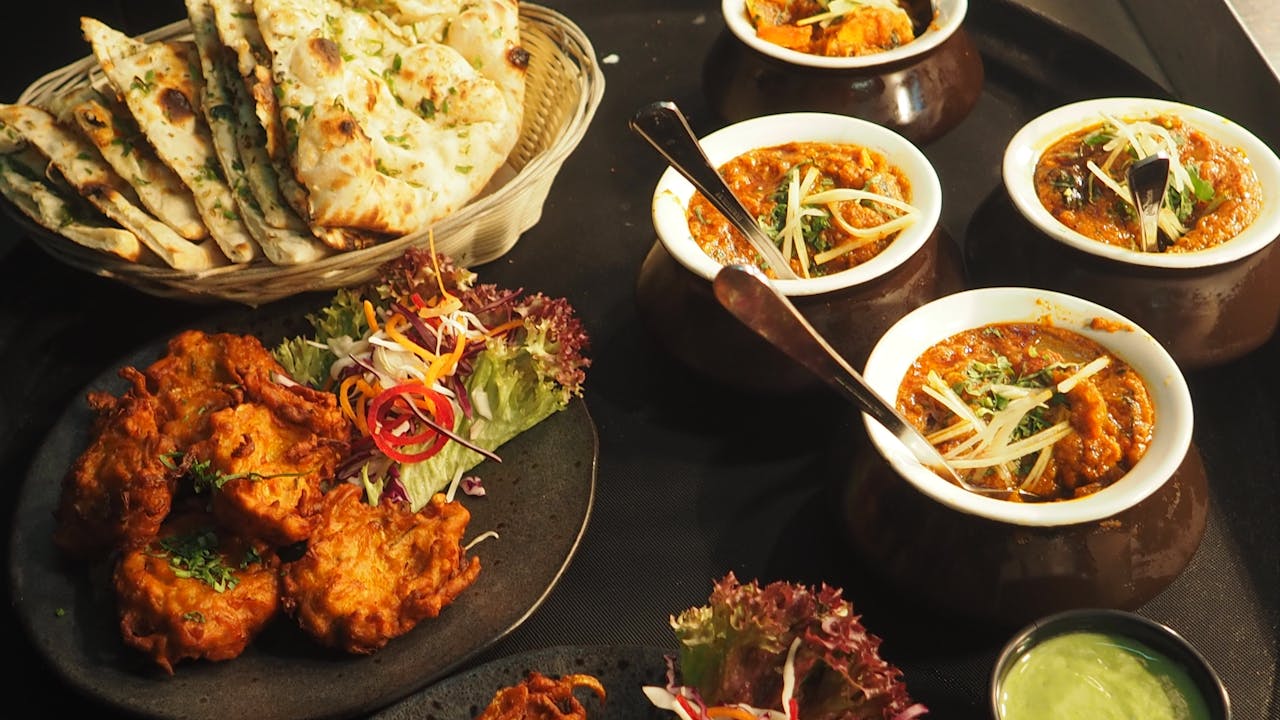
If you are interested in food-related topics and comfortable talking about them, then starting a food blog could help you turn your ideas into a profitable stream of income online.
The best part? Starting a food blog is easier than most people think, even easier than cooking a new recipe or perfecting spaghetti with tomato sauce. With the right ingredients, or better still, with the right blogging strategies, a clear niche, a reliable blogging platform, and a pinch of consistency, you can build a profitable blog that makes you passive income, just like most successful food blogs.
Affiliate Disclosure: This post may include affiliate links with special discounts. Using them saves you money and supports our site at no extra cost to you. Win-win right! Check out our [Privacy Policy] for more details. Thanks for your support!
You might be excited to start a profitable food blog, but that little voice in your head might subconsciously make you feel this is too techy or requires coding or some special equipment.
I get it. I hesitated for months before launching my first blog because I assumed it was too techy or that it would require some technical setup and maintenance.
But the delicious truth was that:
Starting a food blog is easier than baking boxed brownies.
You don’t need to:
❌ Be a tech genius (if you can use Instagram, you can blog).
❌ Have professional chef skills (home cooks have built 6-figure blogs!).
❌ Wait for “perfect” timing (spoiler: it doesn’t exist).
The real secret? Consistency beats complexity.
Yes, growing consistent traffic might take months, but food bloggers who stick with it often hit $20K+/month according to these food blog income reports: Most of these blogs are monetized with;
- Ad revenue from readers
- Affiliate links for kitchen gear
- Sponsored recipes
Think of it like perfecting your signature dish:
- First attempt → Messy but edible.
- Tenth attempt → You’ve tweaked the flavors.
- Fiftieth attempt → People beg for the recipe.
Blogging works the same way. Start simple, keep improving, and soon you’ll have a money-making brand—no tech degree or Michelin star required.
The only wrong move? Not starting at all.
What You’ll Get From This Guide
If you stick with me until the end, you will:
✅ Have Your Own Food Blog – Fully set up and ready to publish your first post.
✅ Know What to Write About – Get clarity on food topics that attract readers.
✅ Learn How to Make Money – Understand exactly how to monetize your blog from day one.
✅ Gain Your First Readers – Discover how to promote your blog and start getting traffic.
Starting a blog isn’t just about writing, it’s about turning your interest in sharing your ideas bout food-related topics into a profitable online business that makes you money passively like many other food bloggers.
When you get started, you’ll be open to;
- Making $5,000 – $15,000 per month: Here is how much food bloggers are making.
- The process won’t take more than 10 minutes and won’t cost more than $3.5/month.
- To get started, you don’t need to code; you can simply use and edit a pre-built website template to match what you want.
- You can monetize your blog on the go with display ads and affiliates, unlike YouTube or other social channels that will need you to build massive amounts of followers before monetization.
- Your website can receive thousands of visitors from normal people around the globe Googling food-related topics you publish.
- After some time, food-related brands can contact you and get you paid for brand sponsorship to promote them on your site.
- This is what anyone anywhere can do anytime, whether you are in America, Europe, Africa, Asia, etc
Many food bloggers are making more than $10k, according to this food blog income report. You can be on
You can make this happen! 🍽️✨ Let’s get started.
Here’s What You Need to Start a Food Blog
Before you start publishing, you’ll need a few essentials:
- 🔹 A Laptop or Desktop – This is your blogging workstation for writing, editing, and managing your site.
- 🔹 A Domain Name – This is your blog’s web address (e.g., “yourfoodblog.com”). Choose something catchy and relevant to food.
- 🔹 A Blogging Platform – WordPress.org is the best choice for beginners—it’s easy to use and gives you full control.
- 🔹 Web Hosting – This is where your blog “lives” online. A reliable hosting service like HostGator ensures your site runs smoothly and is always available to visitors. Plus, it makes setting up WordPress super easy.
Pro Tip: Once you sign up for HostGator, you can install WordPress in just one click and start publishing immediately!
How to Start a Food Blog That Makes Money in 9 Simple Steps
I’ll walk you through setting up your food blog using HostGator, one of the best beginner-friendly web hosting services.
Here is a summary to get you started in just minutes;
1️⃣ . Pick a Food Sub-Niche (More on this below!)
2️⃣ . Click on HostGator to Get Started
3️⃣ . Choose a Hosting Plan
4️⃣ . Pick Your Domain Name
5️⃣ . Adjust Your Hosting Subscription
6️⃣ . Create Your HostGator Account
7️⃣ . Install WordPress
8️⃣ . Choose a Blog Theme
9️⃣ . Customize and Start Publishing
Step 1: Start With a Food Sub-Niche
One of the smartest things you can do when starting a food blog? Pick a specific sub-niche.
Instead of trying to cover everything food-related, including recipes, restaurant reviews, nutrition, and food photography, it’s more effective to focus on a specific sub-niche and expand from there.
Choosing a specific niche helps you:
✔ Stand out in a crowded space
✔ Attract the right audience (people who LOVE what you blog about)
✔ Rank higher on Google (because search engines love focused topics)
✔ Build a loyal following faster
Think about it this way: When people search for food content, they’re looking for something specific. Someone searching for healthy meal prep ideas won’t necessarily be interested in decadent dessert recipes, and a vegan eater won’t care much about BBQ steak recipes.
By picking a sub-niche, you position yourself as an expert and make it easier to grow your blog faster in one area and expand further.
Popular Food Blog Sub-Niches:
- Healthy Eating & Meal Prep – Recipes focused on clean eating, weight loss, and meal planning.
- Comfort Food & Indulgent Recipes – Think mac and cheese, brownies, and fried chicken.
- Vegan & Plant-Based Food – For those passionate about a plant-based lifestyle.
- International Cuisine – Specialize in a particular cuisine (Italian, Thai, Mexican, etc.).
- Homestyle & Family Cooking – Easy recipes for busy parents and home cooks.
- Baking & Desserts – If you love making cakes, pastries, and sweet treats.
- Food & Drink Pairing – Wine pairings, coffee culture, or cocktail recipes.
- Beginner-Friendly Cooking – Recipes that make cooking easy for total beginners.
Which Food Sub-Niche is Right for You?
The best sub-niche is one that:
✔ Excites you – Blogging takes time, so choose a sub-niche you are interested in to fuel your interest and to help you know when you are doing the right topics for your audience, since you already understand those audiences at least slightly.
✔ Has an audience – Make sure people are searching for and interested in your niche.
✔ Has monetization potential – Some niches (like healthy eating or baking) offer better opportunities for sponsorships, affiliate marketing, and ads.
💡 Pro Tip: You can always expand later! Starting with a focused niche helps you grow faster, and you can branch out as your blog gains traction.
No matter which sub-niche you choose, the most important thing is to start. Your blog won’t be perfect at first, and that’s okay! The sooner you begin, the faster you’ll learn, improve, and start building an audience.
🚀 Ready to launch your food blog? Let’s do this!
Step 2: Click “HostGator” To Get Started
After deciding on which foo sub-niche area to go into, you need hosting that won’t slow down your recipe pages. With our discounted HostGator link, our readers have the opportunity of a better hosting deal and a free domain name. HostGator’s tested reliability beats generic hosts, though other web hosting alternatives exist:
- Kinsta (premium for video recipes)
- SiteGround (best for traffic spikes)
- GreenGeeks (eco-friendly hosting)
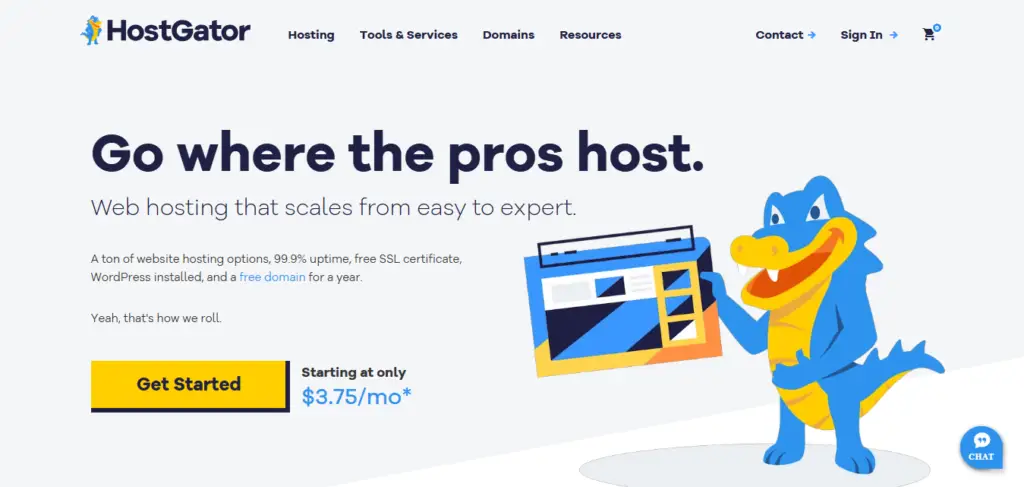
Step 3: “Choose Your Preferred HostGator Plan”
The HostGator Hatchling plan is a smart and budget-friendly choice. Since it’s the entry-level option, you can start small and upgrade whenever you need more resources.

Step 4: Choose a Domain Name of Your Choice
After you pick a plan, you’ll head straight to a page where you can snag your domain and wrap up sign-up.
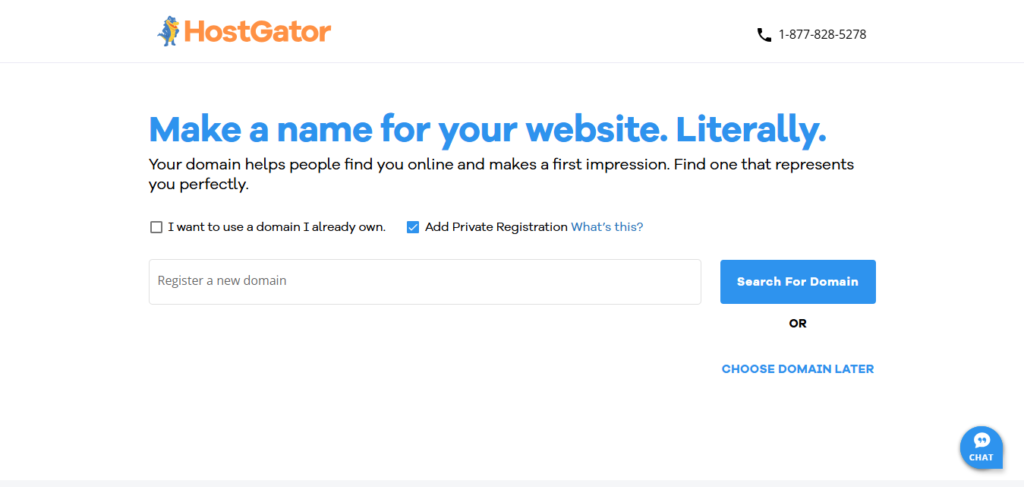
What to consider when choosing a domain name for your food blog
- Make it Tasty & Recognizable – Think of names that immediately signal food, like TastyBitesBlog.com or SavoryAdventures.com.
- Reflect Your Niche – Are you focusing on vegan recipes, baking, or restaurant reviews? Incorporate those elements (e.g., TheVeganPantry.com or DessertAddict.com).
- Keep it Short & Digestible – Something like YumCrave.com is better than AllTheBestHomeCookedRecipesEver.com.
- Easy to Pronounce – Avoid complex names that are hard to say or type, such as GourmetGastronomyGalore.com.
Relevant Resource – Here are some “Unique Food Blog Name Idea and Their Meanings“
Step 5: Adjust Your Hosting Subscription
Double-check that the Hatchling plan is selected on the left and choose a subscription period of either 1 year or 36 months, according to your budget.
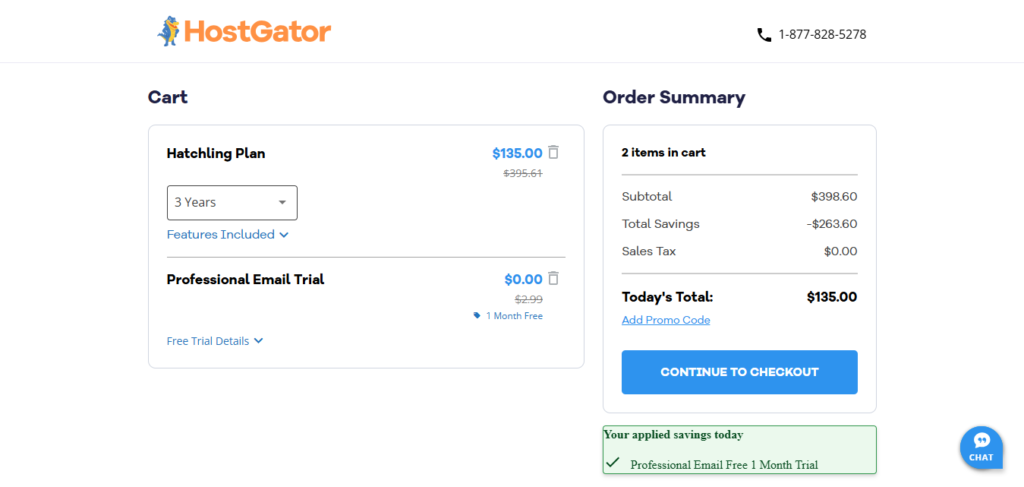
Step 6: Create Your HostGator Hosting Account
Sign up for HostGator by adding your personal details and choosing a strong password.
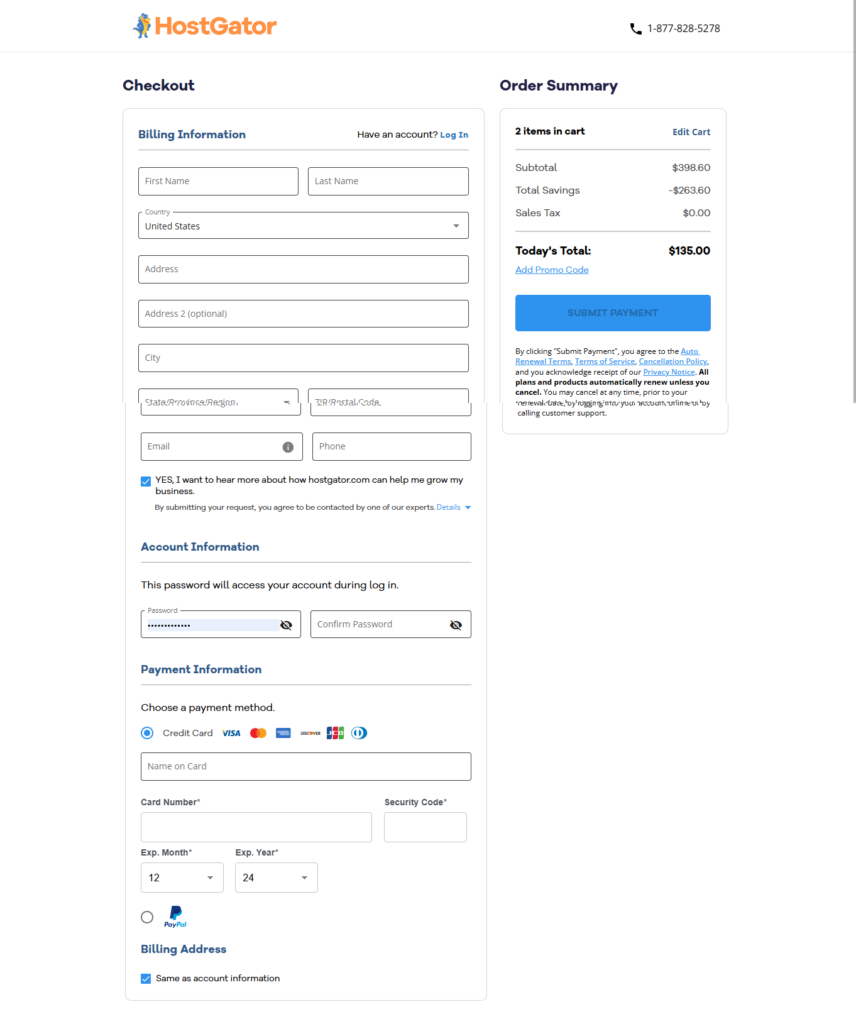
Step 7: Within Your HostGator Account, “Install WordPress”
- At the end of your HostGator sign-up, follow the instructions to install WordPress.
- Alternatively, log into HostGator and click on the “Websites” or “WordPress” section to create your account.
- Once completed, you’ll be logged directly into WordPress to begin writing and designing your blog.
Step 8: Choose a Theme for Your Food Blog
A theme is a pre-built WordPress site you can install within WordPress and customize it to your taste as your new site. There are many free and good-looking WordPress food blogging themes available in WordPress that you can use.
Here’s how to choose a theme for your food blog:
1. Go to Themes: In your WordPress dashboard, hover over “Appearance” on the left sidebar, then click on “Themes.”
2. Browse the Theme Library: Explore free and paid themes. Use the search bar to look for specific themes like “food blog,” or browse popular features such as “grid layout” or “responsive design.”
3. Filter Your Options:
On the left side of the page, you can narrow down your choices. For a food blog, look for themes with:
- Features: Options like image sliders, post formats (for galleries and videos), social media integration, and easy customization.
- Layout: Choose a clean, modern grid layout that’s great for showcasing recipes or photos, and ensure the theme is mobile-friendly.
4. Preview the Theme: When you find a theme you like, hover over it and click “Preview.” This shows you a live demo of the theme, so you can see how it will look on your blog.
5. Check Reviews & Ratings: Read reviews from other users. This will give you insights into the theme’s ease of use, customization options, and support.
6. Mobile-Friendly is Essential: Make sure the theme works well on mobile devices. Most visitors will access your blog from their phones, so it’s crucial to ensure your theme looks great on all screen sizes.
7. Consider Paid Themes (Optional): If you can’t find a free theme you like, consider premium themes with more features and customization options.
However, if you’re a beginner, starting with a free theme is often best until you’re more familiar with WordPress.
Step 9: Customize Your Site and Get Started
Here’s how to customize like a pro:
- Brand Your Blog in 5 Minutes
- Select colors that match your niche (ex, earthy tones for travel, sleek blacks for tech)
- Choose clean, readable fonts (Arial for modern, Georgia for classic)
- Upload your logo or header image
- Essential Pages Every Blog Needs
- About Page: “Who’s Behind This Blog” (builds connection)
- Start Here Page: “New? Read This First” (guides visitors)
- Contact Page: “Work With Me” (for collaborations)
- Publish Your First Winning Post
Try these high-performing formats:- “The Ultimate Guide to [Your Topic]”
- “5 [Niche] Mistakes Everyone Makes”
- “[Current Year] Trends in [Your Industry]”
Pro Tip: Install these free plugins immediately:
- Yoast SEO (optimize your posts)
- Smash Balloon (display social feeds)
- WP Forms (easy contact forms)
You’re Officially Live! Your blog can now:
- Rank on Google (start tracking keywords)
- Build an email list (add opt-in forms)
- Earn income (through ads/affiliates)
First Week Success Plan:
- Set up Google Analytics
- Publish 3 cornerstone posts
- Share each post on 2 social platforms
Find Profitable Food Blog Post Ideas That Make Money
Now that your food blog is set up, it’s time to publish blog posts that attract traffic, engage readers, and—most importantly—make money. Below are proven food blog post ideas that convert visitors into revenue, plus smart monetization strategies to implement right away.
1. Evergreen Money-Making Food Blog Post Ideas
These high-traffic, high-earning post types are perfect for new food bloggers:
Affiliate-Friendly Posts (Direct Earnings)
- “Best [Kitchen Tool] for [Need]” (e.g., “Best Blender for Smoothies Under $100”)
- “Where to Buy [Ingredient] Online” (link to Amazon, Thrive Market, etc.)
- “Budget vs. Splurge: [Product] Comparison” (e.g., stand mixers, knives)
Recipe Posts (Ad Revenue + Sponsorships)
- “Easy [Dish] Recipe for Beginners” (e.g., “5-Ingredient Vegan Brownies”)
- “Copycat [Restaurant] Recipes” (e.g., “Olive Garden Breadsticks at Home”)
- “Meal Prep [Cuisine] for the Week” (great for Pinterest traffic)
SEO-Optimized Roundups (Traffic + Affiliate Links)
- “Top 10 Must-Have Kitchen Gadgets”
- “Best Healthy Snacks on Amazon”
- “Most Reliable Meal Delivery Services”
Pro Tip: Use RankIQ (best keyword tool for food blogs) to find low-competition recipe keywords.
Find More: Affiliate-based Blog Topic Ideas
2. Find Trending & Viral Food Topics
Stay ahead by tracking:
✅ Google Trends (“sourdough discard recipes 2025”)
✅ Pinterest Predicts (“air fryer desserts”)
✅ TikTok Food Trends (“whipped coffee”)
✅ Reddit Threads (r/Cooking, r/EatCheapAndHealthy)
Example Post: “Viral TikTok Recipes That Actually Work (Tested!)”
Find More: Food Blog Topic Ideas
3. Repurpose & Update Old Content for More $$$
Turn past posts into money-makers:
- “2025 Update: Best Protein Powders for Baking”
- “New & Improved: My Go-To Meal Prep Plan” (add affiliate links)
- “Reader Requests: Most Popular Recipes This Year”
SEO Hack: Use SurferSEO (best AI content optimizer) to refresh old posts.
4. Monetization-Focused Food Blog Posts
Sponsored Post Opportunities
- “Honest Review: [Brand] Meal Kit” (reach out to brands for partnerships)
- “[Brand] vs. [Brand]: Which is Better?” (comparisons attract sponsors)
Lead Magnets for Email List Building
- “Free 7-Day Meal Plan PDF” (promote affiliate products inside)
- “Printable Grocery List for [Diet]” (gate it for email signups)
Pro Tip: Use ConvertKit (the best email tool for food bloggers) to automate follow-ups.
5. AI Tools to Speed Up Writing & Research
- ChatGPT → “Give me 10 gluten-free dessert blog post ideas.”
- Jasper → Helps write recipe intros faster.
- Canva → Design Pinterest pins in minutes.
Example Prompt: “Write a meta description for a post about keto air fryer recipes.”
6. Content Calendar for Consistent Earnings
| Weekly Post Types | Monetization Strategy |
|---|---|
| 1 Recipe Post | Ad revenue + affiliate links |
| 1 Roundup Post | Affiliate-heavy (Amazon, Thrive Market) |
| 1 How-To Guide | Sponsorship potential |
Relevant Resources – Profitable Food Blog Post Ideas
How to Start Making Money From Your Food Blog (Proven Strategies)
Your food blog is more than just recipes, it’s a potential income source! Whether you’re sharing family favorites or gourmet creations, these proven blog monetization methods will help you start earning.
Let’s dive into the most effective ways to profit from your passion for food.
1. Display Ads: The Easiest Way to Start Earning
Ads are a hands-off income stream—once set up, they make you money while you sleep.
How to Set Up Ads on Your Food Blog
Step 1: Start with Google AdSense
- Sign up for Google AdSense.
- Submit your blog URL (approval takes 1-3 days).
- Pro Tip: Increase approval odds by having at least 10 well-written posts. (How many posts do you need before making money?)
Step 2: Place Ads Strategically
- Use sidebar banners, in-content ads, and header placements.
- WordPress? Plugins like Ad Inserter make setup easy.
Step 3: Upgrade for Higher Earnings
- Once you hit 50k+ monthly pageviews, apply for Mediavine or AdThrive (pays 3- 5X more than AdSense).
Earnings Potential:
- Beginners: $300 – $1,000/month
- Established blogs: $5K – $20K/month (See real food blog income reports)
🔹 Hot Tip: Food blogs have high RPMs (revenue per thousand visitors) because of lucrative kitchen gadget and grocery ads!
2. Affiliate Marketing: Cash In on Kitchen Essentials
Every time someone buys a blender, cookbook, or ingredient through your link, you earn a commission.
Best Affiliate Programs for Food Bloggers
Kitchen Gear & Ingredients
- Amazon Associates (4-10% on appliances, cookware)
- Sur La Table (8-12% commissions)
- Thrive Market (up to $30 per new customer)
Digital Products
- Cooking Masterclass (sell online courses, earn 30-50%)
- Meal Planning Apps (e.g., Plan to Eat, $20/sign-up)
Cookbooks & Subscriptions
- America’s Test Kitchen ($10+ per sale)
- NYT Cooking (earn on subscriptions)
Find More: Food-based Affiliate Programs
How to Promote Affiliate Products Naturally
- Gear roundups → “Best Stand Mixers for Home Bakers”
- Recipe posts → “This Soup Requires an Instant Pot (Link)”
- Gift guides → “Top 10 Gifts for Food Lovers”
💰 Earnings Potential:
- Part-time: $500 – $2,000/month
- Full-time: $10K+/month (Examples of food blogs making 6 figures)
Pro Tip: Use comparison tables (e.g., “Vitamix vs. Ninja”) to boost conversions.
3. Sponsored Content (Big Brand Deals!)
Food brands pay bloggers to feature their products in recipes or reviews.
How to Land Sponsorships:
- Join networks like Collective Bias, TapInfluence, or AspireIQ.
- Pitch brands directly (check “Work With Us” pages on top food blogs for inspiration).
- Charge $200 – $5,000 per post, depending on your reach.
Earnings Examples:
- Mini-sponsorships (single Instagram post): $100 – $500
- Long-term campaigns (multiple posts + videos): $5k – $20k
Useful Resource: How to Get Your Food Blog Sponsored
4. Sell Your Own Products (Highest Profit Margins!)
🔹 Digital Products
- Recipe eBooks (10–50 each)
- Meal plans (e.g., “30-Day Vegan Challenge”)
- Lightroom presets (for food photographers)
🔹 Physical Products
- Signature spice blends
- Custom baking kits
- Merch (aprons, mugs with your logo)
Success Story: Pinch of Yum sells $50K+/month in eBooks alone! (More food blog success stories)
Find More Ways to Monetize Your Food Blog and Make Money
How Soon Can You Make Money?
- First 3 months: Focus on content + SEO (0–$300/month).
- 6–12 months: Steady income from ads + affiliates ($1K–$5K/month).
- 1–2 years: Scale to $10K+/month with sponsorships + products.
Relevant – (How long does it take to make money from blogging?)
Final Checklist: Start Monetizing TODAY!
Action Steps:
- Apply for Google AdSense.
- Sign up for 3 affiliate programs (Amazon, Thrive Market, etc.).
- Pitch 5 brands for sponsorships this week.
- Plan your first digital product (e.g., “5 Secret Restaurant Recipes”).
For inspiration, check out these successful food blog income reports.
How to Promote Your Food Blog Posts to Increase Traffic
Now that you’ve set up your delicious food blog, created mouthwatering recipes, and added monetization, it’s time to drive traffic to your content. Without visitors, even the most amazing recipes won’t earn you passive income.
The only two sustainable ways to grow your food blog traffic organically are:
- SEO (Search Engine Optimization) – Get free traffic from Google that lasts for years
- Social Media Promotion – Use visual platforms like Pinterest and Instagram to attract foodies
Let’s break down how to use both effectively for your food blog.
1. SEO: The Secret Sauce for Long-Term Traffic
SEO ensures your recipes and food content rank high on Google, bringing in consistent traffic.
Here’s how to optimize your blog posts:
Keyword Research (Find What Hungry People Search For)
- Use SEO tools like:
- Google Keyword Planner (free)
- Keysearch (affordable for food bloggers)
- SEMrush (advanced)
- Target recipe-specific keywords (e.g., “easy chocolate chip cookies recipe,” not just “cookies”)
- Include keywords in:
- Recipe titles
- Headings (H2, H3)
- First paragraph
- Image alt text
Pro Tip: Check our guide to the [best keyword research tools] for food bloggers.
High-Quality Recipe Content
- Google loves detailed, structured recipes with:
- Jump-to-recipe button
- Clear ingredient lists
- Step-by-step instructions
- Helpful tips and variations
- Add helpful content beyond just the recipe (e.g., “How to Tell When Cookies Are Perfectly Baked”)
Find More: How to Write a High-quality Blog Post
Smart Linking Strategy
- Internal links – Connect related recipes (link “Best Chocolate Chip Cookies” to “Cookie Baking Tips”)
- External links – Reference authoritative sites (FDA, USDA) for food safety info
On-Page SEO Must-Dos
- Optimize food photos (compress with TinyPNG, use names like “fluffy-pancakes-recipe.jpg”)
- Improve loading speed (critical for recipe blogs)
- Use schema markup (helps show rich snippets in search)
Tip: For a complete guide, read how to optimize your food blog for SEO.
2. Social Media: Instant Traffic from Hungry Followers
While SEO takes time, social media brings immediate traffic. Best platforms for food blogs:
Pinterest (Top Traffic Source)
- Create vertical pins (1000x1500px) with mouthwatering images
- Use keywords in pin titles/descriptions
- Join food group boards to expand reach
- Post multiple pins per recipe (different angles/styles)
Instagram & TikTok (Visual Food Content)
- Post Reels/Shorts of cooking processes
- Use food hashtags (#Foodie, #HomeCooking)
- Add “Link in Bio” to your latest recipe
Find More Below:
YouTube (Recipe Videos)
- Film cooking tutorials or “day of eating” content
- Add blog links in descriptions
Facebook (Community Engagement)
- Share recipes in foodie Facebook groups
- Go live while cooking popular recipes
Want more methods? Read
Bonus Traffic Boosters
Guest Posting (Backlinks & Exposure)
- Write for other food blogs (e.g., “5 Easy Weeknight Dinners”)
- Include a link back to your blog
- Find opportunities in our [guest posting sites for food bloggers]
Find More:
Email List (Direct Traffic)
- Offer a free recipe eBook
- Send weekly newsletters with new recipes
- Learn how to build an email list for food blogs
Track Performance
- Use Google Analytics to see the top recipes
- And monitor your traffic sources
Essential Food Blogging Tools
- SEO Tools: Keysearch, SEMrush
- Recipe Plugins: WP Recipe Maker, Tasty Recipes
- Photo Editing: Lightroom, Canva
- Social Scheduling: Tailwind (Pinterest)
See our full list of [best blogging tools for food bloggers].
Avoid These Food Blogging Mistakes
Many food blogs fail because they:
❌ Don’t use SEO properly
❌ Post inconsistently
❌ Have poor food photography
Learn More: Common food blogging mistakes and reasons why food blogs fail.
Next Steps
- Optimize old recipes (add keywords, internal links)
- Schedule weekly pins on Pinterest
- Engage daily on Instagram/TikTok
Need more help? Read our [best food blogging strategies].
How Much Money Do Food Bloggers Make?
With this, you can estimate how much you are likely to make, given the number of estimated posts, taking the average time required to get there.
Beginner Food Blogs
- Income: $200 – $2,000 per month
- Traffic: 5,000 – 25,000 monthly visitors
- Number of Posts: 20-50 blog posts
- Average Time: 6-12 months to reach this stage
- Monetization Methods:
- Display ads (low-paying ad networks like Google AdSense)
- Affiliate marketing (earning commissions from promoting kitchen products or food delivery services)
- Sponsored posts (smaller brands)
Average Food Blogs
- Income: $2,000 – $10,000 per month
- Traffic: 50,000 – 200,000 monthly visitors
- Number of Posts: 100-300 blog posts
- Average Time: 1-3 years to reach this stage
- Monetization Methods:
- Premium ad networks (Mediavine, AdThrive)
- High-conversion affiliate programs (e.g., Amazon Associates, equipment brands)
- Sponsored posts (with mid-sized or growing brands)
- Selling eBooks or recipe guides
Established Food Blogs
- Income: $10,000 – $100,000+ per month
- Traffic: 300,000+ monthly visitors
- Number of Posts: 300+ blog posts
- Average Time: 3-5 years or more
- Monetization Methods:
- High-paying display ads
- High-ticket affiliate programs
- Sponsored posts with big brands
- Selling courses, meal plans, cooking classes, or physical products (cookbooks, kitchen tools)
- Subscription-based services or memberships for exclusive recipes
Note: These figures provide a general overview; actual earnings can vary based on different factors on a specific blog.
Find More: Here is an Income Report From Real Food Blogs.
Examples of Food Blogs and How Much They Make
Here are some food blogs to inspire you.
- Root + Revel – $15,000
- Pinch of Yum – Over $60,000
- A Sassy Spoon – $15,843.36
- Butternut Bakery – $5,041.45
[1]. Root + Revel – $15,000/month
Overview: Root + Revel focuses on clean eating, wellness, and natural living. The blog offers recipes, health tips, and lifestyle content, leveraging affiliate marketing and sponsored content to generate income.
- Monthly Income: $15,000
- Monthly Traffic: 100,000 visitors
- Number of Posts: Around 250 – 300 posts
- Methods of Monetization:
- Affiliate Marketing: Partnering with brands for affiliate links and product recommendations.
- Sponsored Content: Collaborations with brands for sponsored posts.
- Ad Revenue: Display ads on the blog.
- Digital Products: Selling eBooks, guides, or courses.
[2]. Pinch of Yum
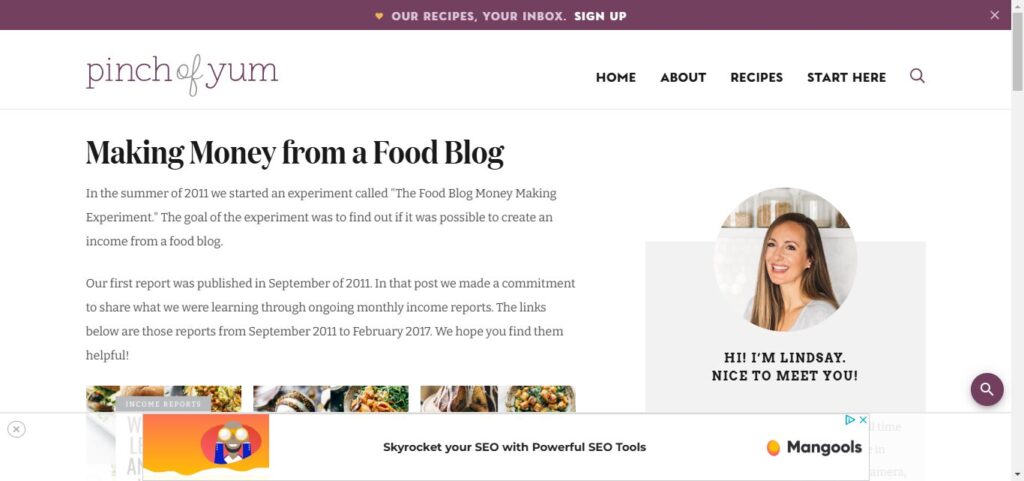
Overview: Pinch of Yum is a popular food blog known for its diverse and easy-to-make recipes. It has a strong presence on social media and utilizes multiple revenue streams, including affiliate marketing, sponsored content, and digital products.
Blog’s Insights
- Monthly Income: $60,000
- Monthly Traffic: 1,500,000 visitors
- Number of Posts: Over 2,000 posts
Methods of Monetization:
- Affiliate Marketing: Recommendations and affiliate links for kitchen tools, ingredients, and more.
- Sponsored Content: Collaborations with brands for sponsored posts and recipe development.
- Ad Revenue: Display ads through ad networks like Mediavine or AdThrive.
- Digital Products: Courses.
[3]. A Sassy Spoon

Overview: A Sassy Spoon focuses on easy and flavorful recipes, often with a Latin twist. It engages readers with vibrant content and monetizes through affiliate marketing, sponsored posts, and ad revenue.
Blog’s Insights
- Monthly Income: $15,800
- Monthly Traffic: Approximately 20,000 – 50,000 visitors
- Number of Posts: 440+ posts
Methods of Monetization:
- Affiliate Marketing: Using affiliate links to promote kitchen tools and ingredients.
- Sponsored Content: Featuring sponsored posts from brands.
- Ad Revenue: Display ads through ad networks like Google AdSense.
- Digital Products: Ebooks.
[4]. Butternut Bakery

Overview: Butternut Bakery specializes in baking recipes and sweet treats. The blog monetizes through a mix of affiliate marketing, sponsored content, ad revenue, and digital products.
Blog’s Insights
- Monthly Income: $8,000
- Monthly Traffic: Approximately 30,000 – 70,000 visitors
- Number of Posts: Around 150 – 200 posts
Methods of Monetization:
- Affiliate Marketing: Partnering with brands for affiliate links to cooking products and ingredients.
- Sponsored Content: Sponsored posts featuring brand collaborations.
- Ad Revenue: Display ads through ad networks like Mediavine or AdThrive.
- Digital Products: Selling eBooks.
Find More: Examples of food blogs and their income ranges, and blogging strategies.
Simplified Summary
Are you passionate about food and dreaming of turning your culinary expertise into a thriving online business? Whether you’re a home cook, professional chef, or food enthusiast, a well-executed food blog can become your ticket to financial freedom and creative fulfillment.
In this comprehensive guide, we’ve covered everything you need to transform your love for food into a profitable digital platform:
- How to Start a Food Blog – From choosing the perfect domain to installing WordPress with ease
- Content Goldmines – Discover recipe ideas, kitchen hacks, and trending topics that keep readers coming back for seconds
- Monetization Mastery – Multiple income streams including ads, affiliates, sponsored content, and even your own products
- Traffic & Growth Strategies – SEO techniques, social media promotion, and email marketing to build a loyal following
- Professional Branding – How to create mouth-watering food photography and develop your unique culinary voice
The food blogging industry is booming, with some top bloggers making well over $10,000+ per month. But here’s the best part – you don’t need professional training to succeed. All you need is the willingness to start and consistently publish blog posts, keep learning about your niche, and improve in the process. This is the only way anyone can do this.
Quick Start Guide: Launch Your Food Blog in 9 Simple Steps
- Step 1: Choose a specific food niche (e.g., vegan desserts, keto meals, budget cooking, or regional cuisine)
- Step 2: Sign up with HostGator (our recommended hosting provider for beginners)
- Step 3: Select the Baby Plan (perfect for new food bloggers with room to grow)
- Step 4: Claim your perfect domain name (think “TheSavorySpoon.com” or “EasyKetoEats.com”)
- Step 5: Choose your billing cycle (12+ months for maximum savings)
- Step 6: Complete your HostGator account setup
- Step 7: One-click WordPress installation
- Step 8: Install a food-friendly theme (we recommend “Foodie Pro” or “Cookely”)
- Step 9: Customize your essential pages and publish your first recipe!
From Kitchen to Keyboard: Your First 90-Day Plan
1️⃣ Week 1-2: Launch with 5 cornerstone recipes (focus on SEO-friendly titles)
2️⃣ Month 1: Set up Google Analytics and Search Console
3️⃣ Month 2: Apply for food-related affiliate programs (Amazon, Thrive Market)
4️⃣ Month 3: Pitch to local restaurants for sponsored content
Pro Tip: Food blogs typically see the fastest monetization through affiliate sales of kitchen gadgets and ingredients.
Why Now is the Perfect Time to Start
- Food-related searches have increased by 62% since 2020
- The meal kit industry alone is worth $10 billion+ in affiliate opportunities
- Pinterest drives massive traffic to food blogs (our students average 50,000+ monthly views)
Your culinary adventure begins today! In just a few months, you could be getting paid to do what you love – cooking, photographing, and writing about delicious food.
🚀 Ready to Explore Other Profitable Blogging Niches?
If you loved this guide, you might enjoy these 15 trending blog ideas—each with proven money-making potential:
🍳 Lifestyle & Home
- How to Start a Lifestyle Blog (Perfect for multi-topic creators!)
- How to Start a Health & Wellness Blog (Easier to rank + affiliate-friendly!)
- How to Start a Home Decor DIY Blog (Crafters and home chefs unite!)
💵 Money & Business
- How to Start a Finance Blog (Think: “Budget meal prep” meets investing!)
- How to Start a Product Review Blog (Kitchen gadgets, anyone?)
👗 Fashion & Beauty
- How to Start a Fashion Blog (Style meets food photography!)
- How to Start a Beauty Blog (Skincare routines + recipe collabs? Yes!)
🌍 Travel & Adventure
- How to Start a Travel Blog (Foodies + travel = dream combo!)
- How to Start an Outdoor Blog (Campfire recipes, foraging guides, etc.)
💪 Health & Fitness
- How to Start a Fitness Blog (Meal plans for athletes!)
- How to Start a Wedding Blog (Catering tips, dessert trends!)
📸 Creative Hobbies
- How to Start a Photography Blog (Food photography = big money!)
- How to Start a Music Blog (Pair recipes with playlist ideas!)
🎯 Specialty Niches
- How to Start a Mom/Parenting Blog (Kid-friendly meals + parenting tips!)
- How to Start an Anonymous Blog (Share secret family recipes safely!)
✨ Pro Tip: Use the same strategies from this guide (niche selection, SEO, monetization) to launch any of these blogs!

